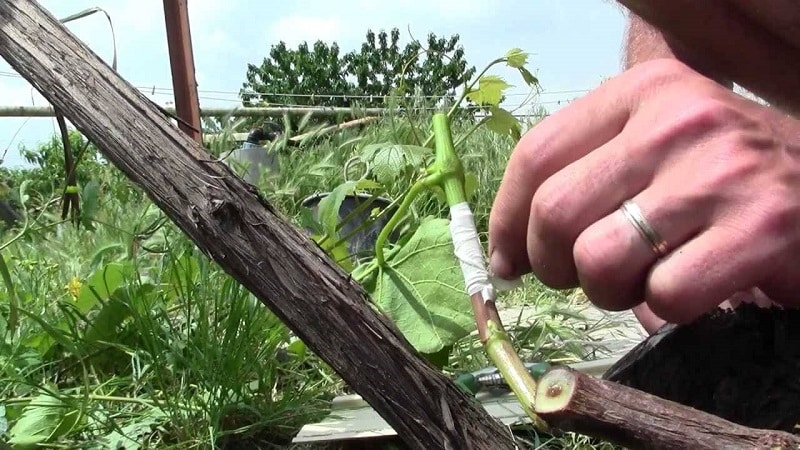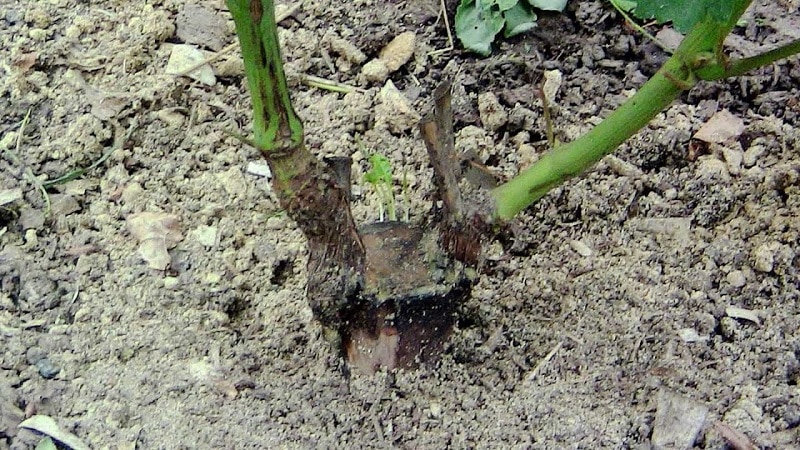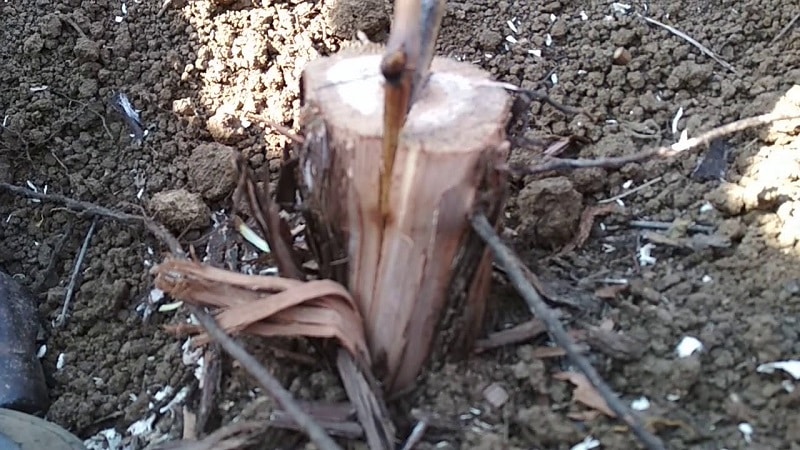Step-by-step instructions for grafting grapes in August
Grafting grapes is not mandatory, but a desirable procedure. It helps to increase the crop’s resistance to negative environmental factors and to obtain a better and more abundant harvest. Some winegrowers graft several varieties onto one plant to save space in the garden.
Vaccination is carried out in spring, autumn, summer and even winter. Spring is considered the most favorable period, but if it was not possible to graft the grapes at this time or the scion did not take root, the procedure is postponed to the summer.
Why graft grapes in August
Grafting grapes improves the quality and vigor of the vineyard. It's not necessary to do this, but the procedure has many advantages:
- Increasing plant resistance to negative environmental factors. Many large-fruited dessert varieties are characterized by low winter hardiness, low resistance to diseases and pests, and increased sensitivity to negative environmental factors. To smooth out these negative aspects, varietal scions are grafted onto more hardy rootstocks.
- Saving space in the garden. There is not always enough space in the garden to plant grape varieties. In this case, cuttings of different varieties are grafted onto the bush. Such a plant not only pleases with the harvest of different berries, but also looks unusual.
- Acceleration of fruiting. To do this, a branch of a plant that is already bearing fruit is grafted onto a new bush.
- Quick variety change. If the grapes growing on the plot are already boring, and you don’t want to wait a long time until the young plants reach fruiting age, a new variety is grafted onto the old base.

Most gardeners prefer to carry out grafting work in the spring, but sometimes they do it in August. Usually in summer the procedure is carried out in 3 cases:
- in the spring there were no suitable, well-developed rootstocks or scion;
- vaccinations given earlier did not take root;
- It was not possible to carry out the work in the spring.
The most common reason is spring vaccinations that have not taken root.. To prevent negative results from happening again in the summer, it is important to find out their possible causes:
- Incompatibility of varieties. This is the least common reason, as most plants go well together.
- The weather is too cold or hot. The problem also arises with frequent sudden changes in temperature.
- Inaccurate match between the scion and rootstock sections. This occurs due to incorrectly made cuts, inaccurately aligned grafted elements, and poor-quality isolation of plant parts.
- Dry weather. During grafting, grapes require more frequent watering.
Grafting work can be carried out in autumn and even winter. However, it is better for novice winegrowers to do this in spring and summer, since during these periods there is a greater chance of success.
Vaccination dates
When grafting grapes in summer, the timing is selected so that the shoots managed to take root and ripen, but did not awaken. The ripened stems will survive the winter and will begin to develop together with the rootstock next spring.
The exact timing depends on the method of vaccination.. Budding is carried out at the end of July or beginning of August. Branches (into clefts) are grafted in June, sometimes at the beginning of July.The underground trunk is grafted from late August to early October or from mid-May to early July.
Favorable days according to the lunar calendar
Gardeners are debating whether it is necessary to take the lunar calendar into account when choosing the time of summer grafting. Some say that it is enough to carry out the procedure at the correct agronomic time, observing the basic rules, while others argue that it will be possible to achieve the best results only in the correct phase of the Moon.
Lunar calendar of vaccination work for 2020:
- April - 3, 5, 6, 9, 11–13, 17, 19, 21, 25–27;
- May - 1, 4, 8, 9, 11, 14, 17, 19, 20, 22, 24, 30, 31;
- June - 5–7, 9–11, 14, 16, 19, 20, 24, 25, 27;
- July - 6, 9, 10, 14, 15, 19, 20;
- August - 3–5, 8, 9, 11, 13, 15, 17, 19, 27, 30, 31;
- September - 1, 5, 6, 13, 15, 16, 22, 23, 25, 27, 28;
- October - 1, 7, 8, 11, 14, 19, 20, 24, 25, 28, 29, 30.
Interesting things on the site:
What care is required for grapes in June?
Preparation
Before grafting grapes in August, a number of preparatory work must be carried out. It is especially important to properly prepare the scion and rootstock: It depends on them whether new shoots will take root or not.
Rootstock
A hardy, frost-resistant plant is used as a rootstock. without signs of disease or pest damage. It should be powerful and have good turgor. A week before the procedure, the grapes are fed and sprayed with a solution of copper sulfate. The day before vaccination, water.
Excess foliage, dried shoots and shoots growing in the wrong direction are removed from the rootstock bush., root shoots. In order for the scion to take root, it is important to avoid shading it with large amounts of greenery.All foliage and shoots, if any, are removed from the branch to be grafted.
Important! Before grafting, the bush is watered abundantly. If after this no moisture is released from the sections, the procedure is repeated.
If the plant is planned to be used as the basis for a new variety (to completely replace the old one), cut off all shoots except those that will be grafted. At the same time, it is important not to disturb the structure of the bush’s skeleton.
The shape of the cut on the rootstock depends on the grafting method. Several shoots can be planted on one vine.

Scion
A shoot from a healthy bush with the best yield indicators is used as a scion., large and tasty fruits. Depending on the method, green or woody shoots are chosen, but green is usually used.
Advice! According to experienced winegrowers, the best results are observed when using a rootstock and scion with the same degree of development.
The day before the procedure, the bush is watered and fed abundantly.. Cuttings are cut in the morning or evening, when the sun is inactive.
Choose even vines of the correct shape, without distortions, spots, etc. The grafting material is taken from the central part of the vine, 10–15 cm away from the top of the shoot.
For summer grafting, cuttings are cut on the day of work.. If this is done several days in advance, the material is wrapped in damp natural fabric. Purchased cuttings are transported in film and kept for several hours in a cloth soaked in a growth stimulant or water before use.
If grafting is carried out immediately after harvesting the rootstock, processing is not necessary.. The cutting is simply placed in a bucket of water while the rootstock is being prepared.In another case, the cut sites are soaked in a growth stimulator, and the branch itself is treated with a solution of copper sulfate (1 tablespoon per bucket of water).
How to graft grapes correctly
The vaccination instructions depend on the chosen method. However there is a few general rules, compliance with which increases the chances of success:
- Garden tools and plants must be treated with a solution of copper sulfate. Do not touch the cut areas with your hands. It is recommended to work with gloves.
- You cannot vaccinate when the sun is active. This will cause the plants to burn and reduce the chances of survival.
- The cut site is hermetically sealed, since when air enters, the tissues do not grow together.
- Sections of the scion and rootstock should be tightly adjacent to each other and match in shape and size. Otherwise, tissue fusion will not occur.
Required materials and tools
For vaccination prepare tools in advance:
- Sharp knife. It is best to use a stationery or painter's knife with a thin blade. Some gardeners use pruning shears or a special grafting device.
- Bucket with water. Used for soaking cuttings.
- Damp cloth. It will be necessary if the vaccination is not done immediately after harvesting the scion.
- Growth stimulants. Store-bought ones (Epin, Mortar) and homemade ones (honey, aloe juice) are suitable.
- Alcohol. For tool processing.
- Copper sulfate. Used to disinfect plants.
- Film. To isolate the connection point. Regular electrical tape and special garden tape are suitable.
- Gloves.
Step-by-step instruction
The budding method is most often used in August.. A grape bud is used, which is applied to the longitudinal incision.
Grafting an eye into the butt:
- The cutting, which will act as a scion, is placed cut side down in a bucket of water. It is left there until the rootstock is selected and prepared.
- Select a bush that will become a scion. A well-developed branch is cleared of foliage and young shoots.
- A well-developed bud is selected from the cutting. It is cut longitudinally so that the length is 3 cm and the depth is about 2.5 mm.
- A bud is selected from a branch of the rootstock. Cut from top to bottom so that the length, shape and depth of the cut on the bark coincide with the scion shield, and the width is 1 mm larger. The cut bud is thrown away.
- The scion shield with the bud is applied with a cut to the prepared cut on the rootstock and pressed tightly.
- The scion is tightly wrapped to the rootstock with film, electrical tape or garden tape. The cut points must be hermetically sealed; only the center of the shield with the bud is left open. The film is removed no earlier than after 2 weeks.

Thus graft the required number of kidneys. They are attached to one or different branches.
To make equal cuts, the scion and rootstock are applied so that the buds on both branches are opposite each other. The cuts are made simultaneously.
Vaccination methods
Is it possible to graft grapes in summer in other ways? There are many methods of grafting work. Each has its own nuances.
To the root
The method is used to rejuvenate a bush or completely replace an old variety with a new one. This allows you to maintain a strong root system, improving the characteristics of the plant.
Usually the procedure is carried out in mid-spring, but some begin it at the end of summer. The grafting is done in a split.
Step-by-step instruction:
- Cuttings are prepared in advance. They should be no thinner than a pencil, mature and well developed.Not green, but lignified cuttings are implanted into the “black head” (as the root scion is called).
- To get a shank, step back 30 cm from the top point of the vine, cutting this part at an angle of 45°. The top part is thrown away. From the cut of the remaining part of the vine, step back 12–15 cm and make an even cut. There should be at least 2-3 eyes left on the resulting chibouk.
- The lower part of the shank is ground with a wedge on both sides to a height of 3 cm.
- The chubuks are placed in a bucket of water or a growth stimulator solution while the scion is being prepared.
- A hole 10–15 cm deep is dug around the root of the bush. The upper part of the bush is cut off.
- A split is made in the center of the base of the stem with a depth that matches the length of the scion blade.
- The scion wedge is inserted into the rootstock base. If it coincides with the diameter of the scion, only one shank is used; if the base is strong enough, several scions are inserted.
- The cut areas are isolated with film.

Into the cleft
Cleft grafting is considered the most common method for beginners. Its advantage is that there is no need to cut the rootstock to the shape of the scion. Here it is enough to carve an even wedge and make a split of the correct depth.
There are 3 methods of cleft grafting: black to green, green to green and black to black. In all cases, cuttings 10–15 cm long are prepared, 30 cm from the end of the vine. Each of them should have 2-3 well-developed buds, which are cleared of leaves.
It is desirable that the diameters of the rootstock and scion match. Before use, the scion branch is cleared of leaves and cut at a right angle.
Vaccination options:
- Green to green. Conducted in the first half of summer (June or July).The plants are first watered, fed, and treated with a solution of copper sulfate. There is no need to soak green cuttings in a growth stimulator or water - just cut a 3 cm long wedge in their lower part, and make a 3 cm deep cut in the rootstock. The junction of the scion and rootstock is hermetically wrapped with film.
- Black to green. Work is carried out at the end of May or beginning of June. The lower part of the previously prepared woody shank is turned with a wedge to a height of 3 cm and soaked in water until the buds swell. Then they are placed in a growth stimulator for half an hour. The upper part of the vine, to which the cutting will be grafted, is cut off. A cut 3-4 cm deep is made in the center. The scion wedge is inserted into the cut of the rootstock so that their eyes look in different directions. The joints are hermetically wrapped with film.
- Black to black. Conducted in the second half of August or early September. One side of the previously prepared lignified cutting is turned into a wedge shape. It is soaked until the buds swell, and then placed in a solution of a growth stimulator. The scion vine is pruned. The cut area is wiped with a clean material soaked in water. A split is made 3-4 cm deep. The scion wedge is inserted into the rootstock split. The junction is sealed with film.

Budding
Grafting of grapes by budding is performed not only in the butt. Eat several other ways to grow a bud:
- T-cut. The scion bud is cut out longitudinally so that the length is 3 cm and the depth is about 2.5 mm. A T-shaped cut is made on the bark of the rootstock so that the length of the vertical line is several millimeters longer than the shield, and the horizontal line is slightly longer than the width of the shield. The scion is inserted under the bark of the rootstock.The junction is sealed tightly, leaving only the eye open.
- Lengthwise cut. The method is similar to the previous one, but instead of a T-shaped one, a horizontal incision is made. The kidney is inserted into the resulting pocket.
- In the sash. An incision is made at the node in the form of flaps. To do this, 2 horizontal cuts are left at the top and bottom of the knot, and 1 vertical in the center. The bark flaps are pulled apart and a bud is inserted.
Read also:
Care after vaccination
After the procedure, it is important to properly care for the plant:
- Immediately after grafting, the bush is watered abundantly and hilled. The soil in the tree trunk circle is thoroughly loosened. After a week, the culture is fed.
- In order for the grafted parts to take root, it is important to water the bush abundantly after the soil dries.
- Every 10 days the condition of the scion is checked. When it takes root, the film is removed.
- If the vaccinations do not take root within a month, they are removed. The work is repeated in the fall or next spring.
Advice from experienced winegrowers
Experienced winegrowers know several secrets that increase the survival rate of grafted parts:
- to activate tissue fusion, add 1 tsp to the growth stimulator where the shanks are soaked. honey;
- to avoid cutting yourself when preparing the scion, wrap your fingers with two layers of adhesive tape;
- Many gardeners do not consider it necessary to soak the stems until the buds swell, leaving them in water only for a few hours.
Conclusion
Most gardeners prefer to graft grapes in the spring. If for some reason it could not be carried out during this period or the vaccinations simply did not take root, the procedure is postponed until the summer.
There are several ways to graft grapes. All of them are easy to implement.The main thing is to follow the basic rules and follow the instructions.